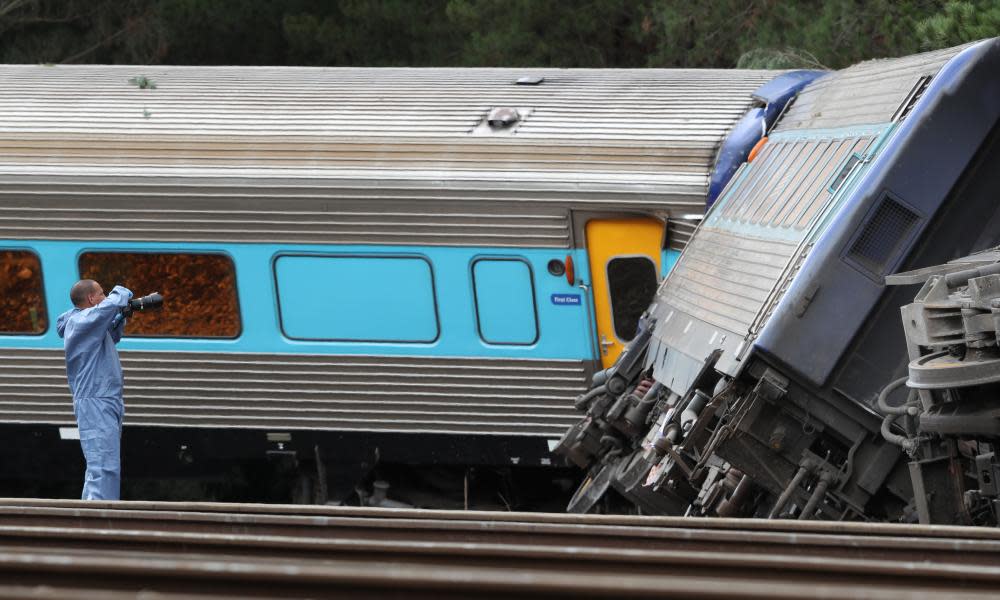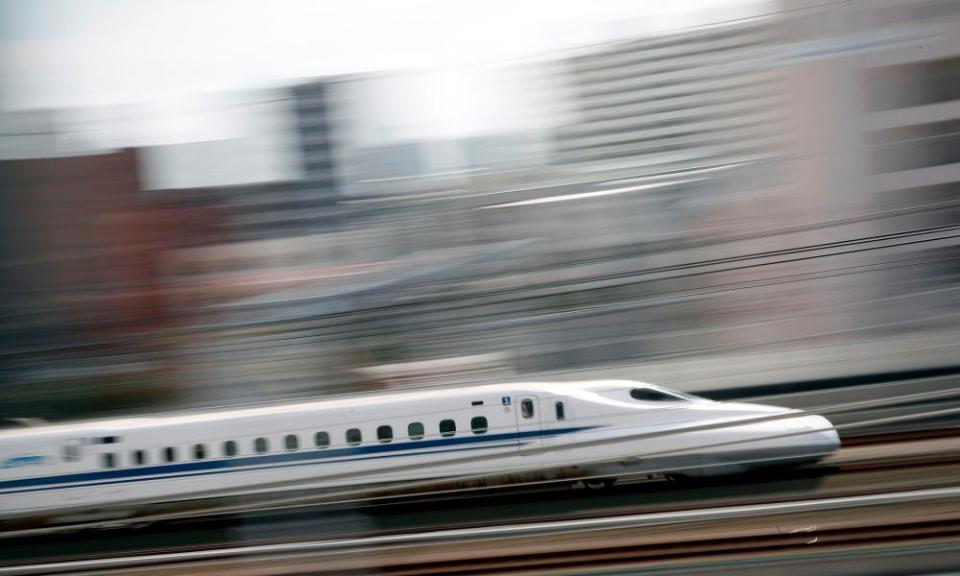From showpiece to goat track: the long, dangerous decline of Sydney-to-Melbourne rail travel

“The Melbourne-Sydney rail line should be the jewel in the crown of Australia’s interstate rail network,” Luba Grigorovitch said.
“Instead, it’s known within the industry as the goat track because it is in such bad condition.”
The secretary of the Victorian branch of the Rail, Tram and Bus Union was grieving the deaths of driver John Kennedy, 54, and his 49-year-old pilot, Sam Meintanis, in last week’s XPT crash near Wallan, Victoria.
In doing so the union leader captured a widespread frustration at the decline of what was once a premium service, but which has now been reduced to a tortuous crawl between Australia’s two largest cities – one that stands in embarrassing contrast to the the development of fast rail in other countries.
As long ago as 1962 the storied Southern Aurora ran the route as a luxury overnight train with a top speed of 130km/h, making the trip in 13 hours. In 1982 the service was replaced by the current XPT fleet, which had a top speed of 160km/h. At their best, the trains shaved two hours off the trip.
By then the world had already moved on. Japan launched its first Shinkansen, or bullet train, in 1964.
Today the Shinkansen is held up as the standard for rail services across the world for speed and reliability. With a top speed of 300km/h, the service connects major cities across 2,000km of track. Its success has inspired similar projects across North America, Europe and China.
But big dreams in Australia of a high-speed passenger rail line connecting Brisbane to Sydney and Melbourne, capable of speeds that would make it competitive with air travel, have died time and time again, leaving the XPT as a clanking relic.
Big dreams, false dawns
The dream has captured the attention of entrepreneurs and politicians alike. Labor leader Anthony Albanese has been a fan of high speed rail since he was industry minister in the Rudd government.
In 1987, a private sector proposal for a VFT backed by Elders IXL, Kumagai Gumi, TNT and BHP led to several major studies being undertaken.
Despite an enthusiastic reception, the plan fizzled out in 1991 after the federal government refused to offer tax concessions.
The next serious investigation of the concept at a federal level began in 1998, when a 270km line between Sydney and Canberra was proposed by the Speedrail consortium at a cost of $4.8bn.
That project failed to get approval from the Howard government, though it would commission a two-part scoping study for an east coast very high speed rail line. The first stage of the report looked on the proposal favourably, but in 2002 the government declined to go ahead with stage two.
The Rudd government commissioned another two reports into a high speed passenger line linking Brisbane to Melbourne, at an estimated cost of $114bn – though the proposed route excluded major population centres.
The idea was later set aside under successive conservative governments, which instead embraced the ready-made commercial viability of a $10bn inland freight line, stretching 1,700km between Brisbane and Melbourne.
The line is now under construction and subject to a Senate inquiry.
Meanwhile, the existing passenger line continued to deteriorate, posing increasing safety problems. In 2010, some 700 mud holes formed along a 208km stretch of track between Albury and Melbourne during maintenance work, causing the rails to visibly warp, creating a “bumpy” ride and forcing speed reductions along the route.
Last week’s derailment was the second in just a few weeks, after another V-Line passenger train clipped a freight train between Chiltern and Barnawartha.
After the crash it emerged that Kennedy had written to a friend just two weeks earlier expressing concern about safety issues on the route.

One track, too many systems
For all the talk about ambitious upgrades to the country’s interstate rail systems, action has proved elusive. It is almost six decades since passengers had to change at Albury because NSW and Victoria had different rail gauges, but standardisation remains a nagging problem in other ways.
Despite efforts to centralise the management of rail infrastructure under the government-owned Australian Rail Track Corporation, chaired by the former National party leader Warren Truss, a patchwork of regulations and safety standards remains.
The secretary of the New South Wales RTBU, Alex Claassens, says a Sydney train driver is likely to pass over track under the authority of three separate entities on any given day, forcing them to switch between three sets of safe work standards.
Crossing the state border brings another set of standards and signalling systems. When a problem on a line has been detected, New South Wales safety standards may impose maximum speed limits of 40km/h. Over the border in Victoria, those limits fall to 25km/h – or may not be imposed at all. Directives about speed limits sent by the ARTC will be among the issues examined in the wake of last week’s accident.
“If we had a system of safe work across the country that meant we can navigate Sydney to Melbourne, one set of track standards, one set of signalling, then we wouldn’t be having this conversation [about the accident last Thursday],” Claassens says.
Fixing it has been fraught with tension between state and federal governments. Whether high speed rail or otherwise, projects that cost billions and will not be delivered for several election cycles have proved unpopular with federal governments.
The states chafe at handing more authority to Canberra, preferring to spend limited funds on maintaining existing rail networks rather than expanding their reach or improving services.
The loss of engineering and management capacity thanks to privatisation has exacerbated the problems.
There are three main companies still manufacturing locomotives in Australia, but the work of planning, building and maintaining rail networks that used to be done by governments has been increasingly outsourced through public-private partnerships.
David Hayward, emeritus professor of public policy at RMIT University, says this loss of capacity has proved costly, particularly as passenger rail is not seen as easy to commercialise.
“The Australian government has become a passive consumer of services delivered by overseas companies as part of global networks of services providers,” Hayward says.
“The only way to deliver now is through private means, where once the opposite was true. We had the capability. The politics might have been against you, but we could still do it.
“The capacity has since been lost.”
Whatever investigators ultimately determine caused Thursday’s accident, it is against this backdrop that the tragedy unfolded: a decades-old fleet running on a seemingly low-priority stretch of track between billion-dollar dreams of a high-speed few and a slow decay in lieu of action.
And in the end, it cost the lives of two men while putting another 153 at risk.

 Yahoo News
Yahoo News 
